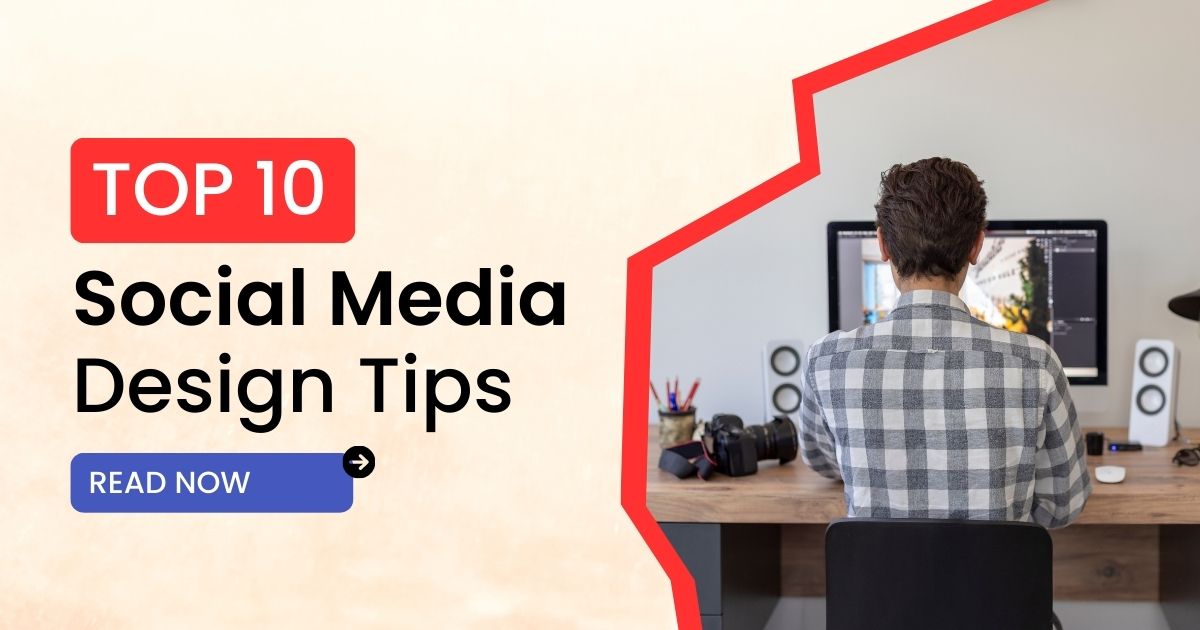
What is social media design?
Social media design is the practice of creating visuals for social media platforms such as Instagram, Facebook, TikTok, Twitter, and more. This includes posts, stories, profile images, graphics, and other visuals to help support your content strategy.
Social media design is important because it helps create brand recognition and adds to the overall aesthetic of a page or profile. It can also be used to make posts stand out in a crowded feed or to capture the attention of potential followers.
For example, a travel brand might use a combination of high-quality photos and professional graphics that feature bold colors to create visually appealing posts. Or a bakery might rely on bright and colorful visuals like pastel frosted donuts or cupcakes with creative typography overlays.
10 important social media design tips
When creating your own social media design, there are a few things to keep in mind.
1. Build a clear visual strategy
Great visuals are only as good as the social strategy that supports them. Your social media design may follow best practices, but without purpose, narrative, timing, and other strategic elements, you’ll be doing your art department a disservice.
Whether you know it or not, all companies have a brand identity and visual language on social—some are just more fluent on social than others. A social media style guide can help with this.
Every visual strategy should include the following:
- Audience research. Do some background on your audience’s interests and think about what type of visual content they’d like to see.
- A mood board. Add content, color palettes, and other visuals that will help shape your direction.
- Themes. Mix things up with recurring themes or pillars. Air France’s Instagram feed, for example, includes a combination of destination shots and airplane photos.
- Platform. Consider how you should adapt your visual strategy for each social channel.
- Timing. Make sure to post visuals on social at peak times. But think big picture, too. Will you need more visual content around certain holidays? Planning ahead will help you better manage your budget and production calendar.
2. Know your design basics
What makes a great social media post design? If you can’t answer this question, a little studying may be in order.
Sure, there’s not one good way to create a social media post. But, there are some basic best practices to take into consideration:
- Have a clear subject. It’s usually best to have a single focal point in your image.
- Remember the rule of thirds. With some exceptions, it’s best not to center your subject perfectly.
- Use natural light. If your image is too dark, it’s harder to see. But don’t overexpose your images, either.
- Make sure there’s enough contrast. Contrast provides balance, is easier to read, works better in black-and-white environments, and is more accessible.
- Choose complementary colors. Get familiar with a color wheel.
- Keep it simple. Make sure your visual is easy to understand.
- Don’t over-edit. Resist the temptation to press all the buttons. Subtly is a good policy when it comes to filters and features. Increase saturation with caution.
3. Take advantage of free tools and resources
It’s almost always best to hire a photographer or graphic designer to create custom content for your brand. But if your budget is tight, or you’re in need of a few extra tools, there are countless resources available to help you create eye-catching social media designs.
4. Watch out for copyright
Sourcing images for social media isn’t always easy—especially when it comes to understanding image copyright. But it’s important, especially since there are serious consequences for misuse.
Read all the fine print when using stock photos, templates, and illustrations. If anything is unclear, inquire with the image owner or site for more detail.
The same goes for licensing and contracting. When drawing up contracts with artists, it should be clear where you intend to use creative, who owns the rights to it, etc.
When it’s called for (which is often), be sure to give credit where credit is due. That’s also true if you plan to repost or share user-generated content.
5. Size images to spec
One of the biggest crimes you can commit when creating social media designs is using the wrong image size.
Images with the wrong aspect ratio or low resolutions can be stretched, cropped, and crunched out of proportion—all of which reflects poorly on your brand.
Every platform has its own specifications, and you should tailor your content accordingly. We’ve assembled a social media image size guide to help you.
A few social media image sizing hacks:
- Optimize horizontal Stories. Want to share a horizontal photo in a Story? Create a background or use a template, so it doesn’t look small and sad.
- Consider all devices. Stories and other vertical content display differently depending on the device being used. Check your analytics to see what devices your audience uses. If there’s a trend, size accordingly.
- Pay attention to pixels. Don’t put anything important in the upper and lower 250-310 pixels.
- Preview before posting. Preview how Instagram will crop a vertical photo on your grid by looking at the filter thumbnails before you publish.
6. Be tasteful with text
Whether you plan to create quote images, stylized typography, or use text overlays, less is always more when it comes to word count.
Text in social media design should always be bold, legible, straightforward, and concise. Make sure there’s enough contrast between the text and background so that it’s readable. The Web Content Accessibility Guidelines (WCGA) recommend using a contrast of 4.5 to 1. There are several free contrast checkers available if you’re not sure how to do this.
Here are a few tips to keep in mind when including text in images:
- Spell-check. Triple-check spelling and grammar. Tools like Grammarly and Google Docs can make this easy.
- Choose the type wisely. Font can affect both tone and legibility.
- Mix fonts carefully. If you need to mix fonts, pair a serif with a sans serif.
- Be color savvy. Avoid green and red or blue and yellow color combos. According to WCAG, they’re more difficult to read.
- KISS (keep it simple, stupid). Keep line length short.
- Look out for orphan words. Leaving one word on the last line can look odd.
- Get moving. Animate text to make it stand out.
7. Be mindful of representation
Do the people in your creative reflect the diversity of your audience? Are you reinforcing gender or racial stereotypes with your visuals? Do you promote body positivity?
These are a few of the questions you should be asking when making your next social media graphic design.
Doing so is not just socially responsible; it’s smart. It’s much easier for someone to imagine themselves using a product or service if they see someone that looks like them doing it. Look at your audience analytics or the demographics of your desired market, and factor them into your creative process.
Representation should be about more than just optics. If you have the means to diversify your team, do it. Hire women and creators of color. Bring as many perspectives to the table as you can.
At the very least, try to get feedback from as many voices as possible before sending your creative off into the world.
8. Prioritize accessibility
Not everyone experiences visual content the same way.
When producing your social media designs, make them accessible to as many people and contexts as possible. Accessible content allows you to reach a broad audience and possibly edge out non-inclusive competitors in the process.
More importantly, it helps you earn respect and loyalty from customers.
Accessible social media designs can include:
- Alt-text descriptions. Alt-text allows the visually impaired to appreciate images. Facebook, Twitter, LinkedIn, and Instagram now provide fields for alt-text image descriptions. Here are some tips for writing descriptive alt-text.
- Subtitles. All social videos should include captions. Not only are they crucial for hearing-impaired viewers, but they also help in sound-off environments as well. Language learners also benefit from subtitles. Plus, people who watch videos with captions are more likely to remember what they saw.
- Descriptive transcripts. Unlike captions, these transcripts describe the important sights and sounds that aren’t spoken or obvious. Descriptive audio and live-described video are other options.
9. Optimize for SEO
Yes, your social media designs can and should be optimized for search engine optimization (SEO), too. Social media SEO involves adding keywords, title tags, and image alt text to improve the visibility of your posts in search results.
Consider using keywords when designing social media graphics and creating captions for posts. Additionally, make sure to use descriptive language that relates to topics associated with your post and brand. This will help people find your content on social platforms by typing it into a search bar or clicking on related hashtags.
For example, if you are designing social media graphics for a clothing store, you might consider using keywords such as “fashion,” “style,” and “clothing” in the captions and titles. Use hashtags associated with your content to increase visibility on social platforms.
10. Be creative
Pshhh, easy, right?
But seriously. Forget the awards; creative work is always rewarded by customers with likes, comments, shares, and sales. And it has to power to earn new followers, too.
Having trouble coming up with social media post design ideas? Here’s a little inspiration for you.
Venmo uses social media graphic design to create a hypnotizing motion graphic.
Meow Wolf uses a creative carousel to tell a story beyond the caption.
Bon Apetit Mag uses bold, colorful designs to announce its latest best-new restaurant winners.
The Washington Post adapts listicles for the Instagram carousel.
All Birds takes a design-forward approach to static social media graphics.
National Geographic uses simple text on images to attract user attention on a busy Twitter feed.

